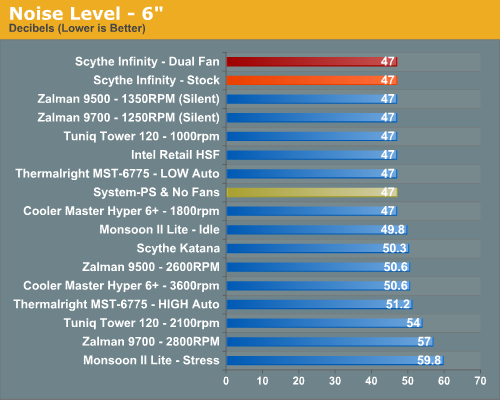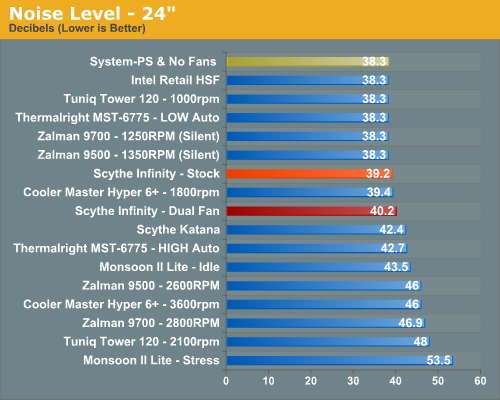Scythe Infinity: 5 Heatpipes and Silent 120mm Fan
by Wesley Fink on February 26, 2007 12:05 AM EST- Posted in
- Cases/Cooling/PSUs
Noise
For many enthusiasts upgrading cooling the goal is maximum stable overclock, and they will live with the inconvenience of a louder system. For other users silence is the most important factor, and these users will forgo maximum overclocking if this increase system noise levels. In general the Zalman 9500 and 9700 can be considered very quiet, but performance of either cooler is not standout against the competition - at least where noise is concerned.
To test idle and load noise levels, a Zalman Fan Mate 2 fan controller was used to dial in the lowest and highest fan speeds the fan could achieve. The difference in noise levels between low and high were negligible with the Scythe 120mm fan, so only high levels, which are generally below the system noise floor are reported. Tests were also run with a push-pull dual fan setup using two Scythe 120mm silent fans. These results are reports in the noise graphs as Dual Fan.
There are virtually no power supplies that do not have a fan. While Zalman and a few others do make a few expensive fanless power supplies, we have not seen a fanless unit larger than 500W, or one that would be used for seriously overclocking a system. With that in mind the noise level of the system with all fans turned off except the power supply was measured. The power supply used for the cooling test bed was the OCZ PowerStream 520, which is one of the quieter of the high performance power supplies. The noise level of the power supply was 38.3dB from 24" (61cm) and 47dB from 6" (152mm). The measured noise level of the test room is 36.4dB, which would be considered a relatively quiet room with a noise floor slightly below the OCZ PowerStream 520 PSU.


Measured noise levels in this chart should be considered worst case. Measurements were taken with an open side of a mid tower case 6" from the open HSF and 24" from the open HSF. Real world would be a completely closed case with a further reduction in noise.
The low-noise results with the Scythe Infinity are truly impressive. The stock single fan configuration scored some of the lowest noise results we have tested so far, generally remaining at or near the noise floor at both measurement distances. Even more impressive were the results with a dual-fan push-pull configuration. Noise results barely increased with two fans, again remaining at or near the system noise floor. Considering the Scythe matched our highest Tuniq overclocking results when running two fans, this is very impressive silence.
As already pointed out, any 120mm x 25mm fan should be mountable on the Infinity with a set of Scythe fan wires. The shipping fan is 1200 RPM and selected for silence. It's hard to complain about the noise measurements with this fan - single or dual. However, if you have a favorite silent fan or performance 120mm fan it should mount and work fine on the Scythe Infinity.
While the Scythe matched the Tuniq in overclocking and tied for the best OC with an air cooler, it is clearly the winner in silence at high speeds. This is true whether you run a single stock fan or dual silent fans. The Infinity is certainly bulky, as are most effective heatpipe towers, but fans of low noise cooling should definitely add the latest Infinity to their shopping list.
For many enthusiasts upgrading cooling the goal is maximum stable overclock, and they will live with the inconvenience of a louder system. For other users silence is the most important factor, and these users will forgo maximum overclocking if this increase system noise levels. In general the Zalman 9500 and 9700 can be considered very quiet, but performance of either cooler is not standout against the competition - at least where noise is concerned.
To test idle and load noise levels, a Zalman Fan Mate 2 fan controller was used to dial in the lowest and highest fan speeds the fan could achieve. The difference in noise levels between low and high were negligible with the Scythe 120mm fan, so only high levels, which are generally below the system noise floor are reported. Tests were also run with a push-pull dual fan setup using two Scythe 120mm silent fans. These results are reports in the noise graphs as Dual Fan.
There are virtually no power supplies that do not have a fan. While Zalman and a few others do make a few expensive fanless power supplies, we have not seen a fanless unit larger than 500W, or one that would be used for seriously overclocking a system. With that in mind the noise level of the system with all fans turned off except the power supply was measured. The power supply used for the cooling test bed was the OCZ PowerStream 520, which is one of the quieter of the high performance power supplies. The noise level of the power supply was 38.3dB from 24" (61cm) and 47dB from 6" (152mm). The measured noise level of the test room is 36.4dB, which would be considered a relatively quiet room with a noise floor slightly below the OCZ PowerStream 520 PSU.


Measured noise levels in this chart should be considered worst case. Measurements were taken with an open side of a mid tower case 6" from the open HSF and 24" from the open HSF. Real world would be a completely closed case with a further reduction in noise.
The low-noise results with the Scythe Infinity are truly impressive. The stock single fan configuration scored some of the lowest noise results we have tested so far, generally remaining at or near the noise floor at both measurement distances. Even more impressive were the results with a dual-fan push-pull configuration. Noise results barely increased with two fans, again remaining at or near the system noise floor. Considering the Scythe matched our highest Tuniq overclocking results when running two fans, this is very impressive silence.
As already pointed out, any 120mm x 25mm fan should be mountable on the Infinity with a set of Scythe fan wires. The shipping fan is 1200 RPM and selected for silence. It's hard to complain about the noise measurements with this fan - single or dual. However, if you have a favorite silent fan or performance 120mm fan it should mount and work fine on the Scythe Infinity.
While the Scythe matched the Tuniq in overclocking and tied for the best OC with an air cooler, it is clearly the winner in silence at high speeds. This is true whether you run a single stock fan or dual silent fans. The Infinity is certainly bulky, as are most effective heatpipe towers, but fans of low noise cooling should definitely add the latest Infinity to their shopping list.










39 Comments
View All Comments
SmokeRngs - Wednesday, February 28, 2007 - link
The information you wanted is there. Why are you complaining? There are plenty of people that don't care about the information you want but do want the information you deride. Both are there in a clear and concise manner for those that want to see one or both.
shabby - Monday, February 26, 2007 - link
People who buy $50 heatsinks dont buy them because they're quiet, they buy them so they can overclock their cpu's. Plus they probably stick higher cfm fans, so they're not quiet anymore.Zambien - Monday, February 26, 2007 - link
I disagree. When I bought my Zalman 7700cu for my current PC, the main reason was that it would provide similar cooling to my current HSF, with less noise. I didn't like the fact that my computer sounded like a jet engnine. I'm sure some people fall into the category, but others do not.cujo - Monday, February 26, 2007 - link
why wouldn't you test with overclocks?arswihart - Monday, February 26, 2007 - link
Not to mention they are talking about 50Mhz differences in OC to separate better and lesser performing heatsinks. Come on, that isn't even a significant difference. Did they repeat the result on multiple systems, or just the one. Does it matter? Of course not.arswihart - Monday, February 26, 2007 - link
A heatsink doesn't do anything magic to give you higher OC's, it gives you lower temps, which will then let you OC higher.Measuring a CPU's OC is looking at data that is a step removed from what you should be looking at, which is simply the temperature. I could care less what they get to OC to, it will be almost certainly different for anyone who buys the heatsink.
The only thing that I think is worth taking away from any heatsink review is: installation caveats, temps, and noise.
shabby - Monday, February 26, 2007 - link
I find it funny that the infinity cant beat the tt120, does it have thicker heatpipes or what. What part of the tt120's construction make it better then other beefier/bigger coolers?Superdoopercooper - Monday, February 26, 2007 - link
The first rule in A-B testing is to hold EVERYTHING constant except for the items being examined/tested.Therefore, in ALL of your heatsink reviews, the system down to the THERMAL COMPOUND should remain fixed, even if the heatsink ships with some "higher end" stuff.
I think it would be wise to pick ONE thermal compound and use it on EVERY heatsink test. Then you are testing the performance of the heatsink (i.e. Heatsink #1 is better than Heatsink #2, with no exceptions), and not the thermal grease + heatsink.
I would hate to think that heatsink #1 was the best, but only because it shipped with better compound than another. I think many people ponying up for these higher-$$ heatsinks will pony up $6 for some good thermal grease.
Then, if you want to do an additional test that comments on the performance of the included thermal grease, that would/could be helpful to potential buyers.
Wesley Fink - Monday, February 26, 2007 - link
I can easily link you to a review from a respected source that proves toothpaste and Kraft Vegemite are superior in cooling to Arctic Silver 5 :-) I have tested many thermal compounds and found little differnece among the quality products. That conclusion was a rude awakening for me. I have found much more variation in perfromance in how the thermal grease was applied than I have ever found in the thermal compounds themselves.Thus far, all of the tests have used our standard silver-colored (but no real silver content) tube thermal compound except the Thermalright MST 6775 and the Zalman pair. These came with top thermal grease, and yet none of the three beat our Tuniq or this Infinity. If the cooler company cares enought to supply a premium thermal compound we test with that compound.
Superdoopercooper - Monday, February 26, 2007 - link
If it is true that all thermal compounds are nearly equal, then I guess that's fine. I would like to see the link, actually.That still doesn't change the fact that the best A-B testing holds EVERYTHING constant except the single item being tested.
Since AT is the site I hold in the highest regard in terms of info on computer components, I thought I'd just throw up my $0.02 on ways to maybe make these tests "better" and/or more scientific.
Could just be my test engineering background talking. :-P